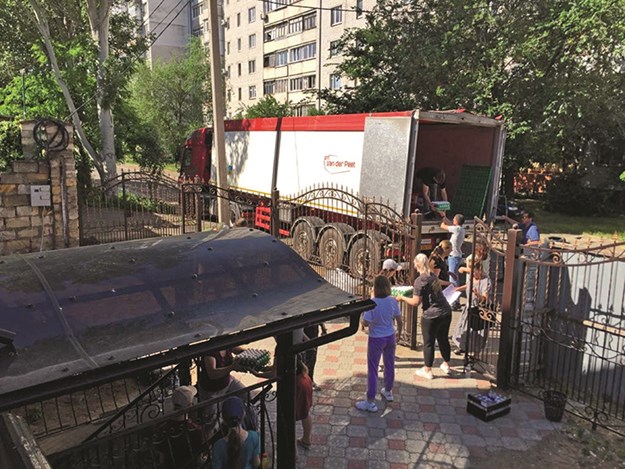Chris McCullough takes us behind the wheel of a Dutch truck taking food into, and out of, Ukraine
Getting humanitarian aid into Ukraine is, at present, relatively straightforward, but helping the nation with its agricultural exports is another matter entirely.
That’s according to Gerjan Wielink, a Dutch truck driver who has been assisting with the humanitarian effort.
Wielink runs his own agriculture trading and transport company at Dronten in The Netherlands, and decided to volunteer his services and his trucks to transport humanitarian aid, mainly food, to various towns and cities desperate for help, soon after the Russian invasion.
Wielink and two of his drivers, have just completed their fourth trip to Ukraine clocking up over 4,500km each, delivering food into the war-torn cities of Kharkiv, Odesa and Mykolaiv.
This time, however, the convoy ventured southwest on the return journey to pick up loads of grain in Cherkasy, 200 km south of Kyiv, which had been sold in The Netherlands.
 |
|
Gerjan Wielink and driver Alfred Aarten have been bringing humanitarian aid into Ukraine during the conflict
|
While Wielink has planned more similar trips he says there are many challenges including slow border checks, language barriers and limited supplies of diesel.
“We have been over in Ukraine four times now delivering food and built up a good relationship with the border guards, but crossing can take a long time,” he says.
“Normally we cross the border entering from Lviv in Ukraine where local truck drivers are waiting for up to five days to cross, but we usually can pass the kilometres of queues as we are on humanitarian runs.”
Using special trailers with walking floors, Wielink and his team were able to transport pallets and boxes of food to the besieged cities, and then load up with loose barley on the return leg. The walking floors make it easy to unload the grain at its final destination.
The three trucks then collected 22 tonnes each of barley at a Ukrainian property owned by Dutchman Kees Huizinga and successfully delivered it to the customer in The Netherlands, but had to wait 27 hours at the border crossing.
“The walking floor trailers were perfect to transport the humanitarian aid out and collect the grain on the way back,” said Wielink.
“With all the Ukrainian ports blocked by the Russians, the farmers in Ukraine have no way to export their much-needed grain to countries around the world. People are going to starve in some developing nations if they don’t get Ukrainian grain.
“I know the 66 tonnes we hauled out is just a small amount going into the EU but it’s a start, and gives the farmer some more storage space for this year’s harvest which is starting soon.”
 |
|
The work has involved bringing food into, and out of, Ukraine
|
Negotiating the border and busy Ukrainian roads was a challenge on this trip for Wielink but he also faced fuel shortages.
“Once we crossed the Dnipro River in Ukraine the roads in the west of the country became very busy with traffic as life starts to return to normal there,” he says.
“Fuel is also in very short supply there. We were lucky the farmer was able to spare a few litres to allow us to get to the border, but my fuel light came on just as I was crossing. Luckily, I made it to a gas station 60km from the border in Poland.
“But it’s the crossing that presents the biggest challenges.
“Even though we passed many Ukrainian trucks in the queue we still had to wait 27 hours at the border.
Wielink said he found there as a significant language barrier with the Polish authorities.
“There are only two guards on duty there and one of them even had to phone his daughter to translate into English for us to understand,” he says.
“There really should be grain corridors in operation at several border crossings so we can run quicker across the border to get grain out of Ukraine.
“The checks are very strict indeed. If the trailer weighed 10kg more than it should, then that can cause a major headache.”

